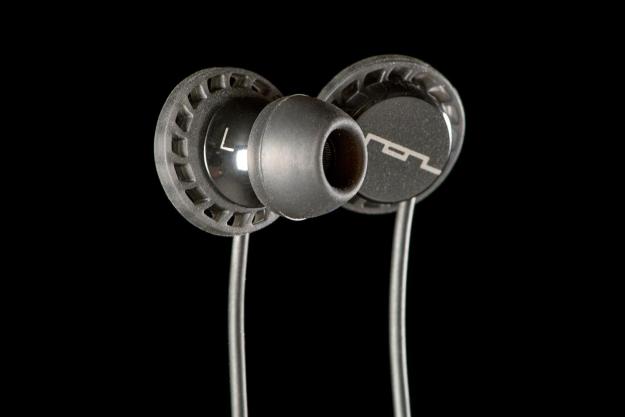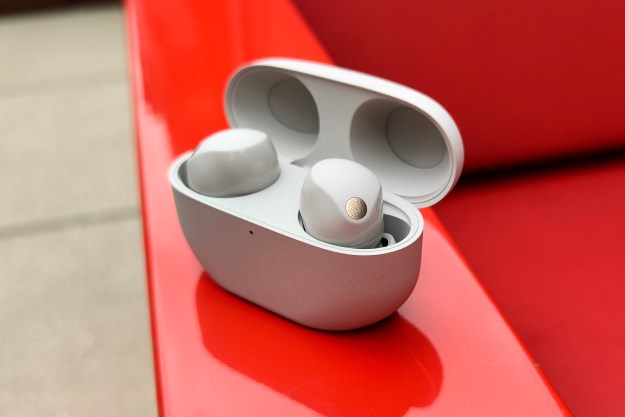
“… the Relays succeed wonderfully where so many others before them have failed: they stay put under pressure, and they do so comfortably.”
- Balanced, accessible sound signature
- Stable, no-hassle fit
- Water and sweat resistant
- Attractive design
- Detail and definition doesn’t rise above entry-level status
- A little pricey
Sol Republic has a flair for designing unique headphones that epitomize the sought-after virtues of form and function. The backbone of the company is its Tracks series, an expansive line of modular headphones constructed around an interchangeable and near-indestructible polymer headband. Thanks to the success of the Tracks lineup, Sol has recently expanded its reach into new segments, including a partnership with Motorola that yielded a DJ-style portable Bluetooth speaker, the Deck.
The company’s latest brainchild is a pair of ‘crossover’ in-ear buds designed to work well in any scenario, called the Relays. Utilizing proprietary tech called Free Flex, the Relays promise style, durability, and a hassle-free fit that will hold-up under the stress of your daily workout or your daily commute, all for only $80. We recently spent some quality time with the Relays to find out if this ‘crossover’ could win our affections.
Out of the box
Much like their price, the Relays’ packaging skates the line between budget and premium. It’s the kind of box you might feel bad about throwing out, but probably will eventually. We pulled a tab protruding from the cardboard shell to reveal a slim black box within, encased in plastic, and harboring the buds at the sidewall. The inner compartment housed the main length of cable, and a small collection of accessories including three sizes of silicone tips, and a black carrying pouch.

We popped the Relays loose and got our first close look at the Free Flex material, which consists of a spongy, rubberized circlet around a host of spokes attached to the housing of each earpiece. Pressing on the material induced a lot of give that allowed the ring to expand and contract easily. We also noticed the earpieces were sharply angled, presumably to help them penetrate deeper into the ear canal.
Features and design
While the Relays may be a bit odd aesthetically, they still manage to look pretty sharp while working around their funky Free Flex halos. The main housing is svelte, and the buds are also quite light, barely registering in our hand as we carted them around. The exterior of each earpiece is carved into a succinct black cap, monogrammed with the Sol logo in flashy silver. Along with our black test model, the buds come in a variety of colors, including white on black, blue, and yellow, with more likely to come as the product rolls out.
While the Relays may be a bit odd aesthetically, they still manage to look pretty sharp while working around their funky Free Flex halos.
The Relays’ ultra-thin bifurcated cable extends from directly behind the Free Flex ring and adjoins at a small plastic bead at the center, which also supports the removable clothing clip. Six inches down from the left bud is a matte black control mic – we received the single-button Android version, but an iOS-compatible full control version is also available for the same price. The cable terminates at a 90-degree angled jack with gold plating.
Comfort and fit
Our first big test for the Relays was to see if they really could stay in place through one of our not-so-fluid, pavement-slamming jogs around the neighborhood. More than most users, we have an extremely hard time getting standard buds to stay in place, and even the newer iPhone Earpod design has a tendency to slip out after a few minutes of struggling up a hill.
We inserted the Relays with a firm push, and found they not only felt extremely stable, but the hard-angled drivers did indeed push deeper into our ear canal. The fit felt a little invasive at first, but we soon got used to it, and the Relays ended up feeling about as comfortable as any standard in-ear. We were glad for the included clothing clip, as the cable generated a lot of noise when it rubbed against surfaces. Once secured, the Relays offered a decent level of passive noise isolation.
We then set out on our run. We were happy to find that, after a good 15 minutes, we felt nothing more than some slight movement from the left bud, having to guide it back into place only once. The ear tips didn’t stay perfectly within the sonic sweet spot, but they didn’t fall out either, and for us, that’s a big coup.
Audio Performance
So, the Relays look pretty good, and they actually stay in your ears while exercising without any of the hassle you’ll experience with earhook-style sports buds – an impressive feat, no doubt. But for many, sound quality is as important, if not more so, than a secure fit. Spoiler Alert: If you’re looking for a product that offers a significant improvement in audio quality over your iPhone buds, you won’t find it here. While the Relays have their moments, they provide an extremely safe sound signature that’s light on detail and leaves a good deal of depth and instrumental timbre by the side of the road.
If you’re looking for a product that offers a significant improvement in audio quality over your iPhone buds, you won’t find it here.
When we turned to more complex productions, however, the Relays got in over their head pretty quickly. The latest Vampire Weekend album, Modern Vampires of the City, was wrought with pitfalls the ‘phones simply couldn’t overcome. The space and subtle details of the album were lost in a husk cast by other, more forward instrumentation. And percussion, especially snare drum and hi-hats, was often served with a static, plastic-y tone, accenting the click of the attack, while showing very little resonance. The buzzy acoustic guitars at the entrance of the track “Finger Back,” for instance, had so little color or definition, they almost sounded broken.
Moving through other genres, the headphones continued to do a good job with overall frequency balance, which can be a challenge in the under $100 crowd. The midrange was clean enough, and bass was relatively powerful when called upon, without being too boom-y. The treble did get a little bright occasionally, such as during Muse’s “Supermassive Black Hole.” The main hits of the groove had a tinny coloration, and the vocals were served with a sibilant cut to ‘S’ sounds that was slightly uncomfortable. Still, for most of our evaluation we experienced little irritation, and the sound was delivered clearly, with all of the main points intact.
Conclusion
The difference between the sound of premium headphones and the Sol Republic Relays’ more rudimentary sound is a bit like the difference between reading a great story vs. having a friend explain it to you; you’ll get the gist of everything from your pal, but it’s just not the same. For that reason, we simply wouldn’t choose the Relays based purely on their sound quality. Still, the Relays succeed wonderfully where so many others before them have failed: they stay put under pressure, and they do so comfortably. We can imagine there are plenty of listeners who would give a little on fidelity in exchange for the peace of mind and sanity that comes with never having to worry about their ear buds getting in the way of their workout.
Highs
- Balanced, accessible sound signature
- Stable, no-hassle fit
- Water and sweat resistant
- Attractive design
Lows
- Detail and definition doesn’t rise above entry-level status
- A little pricey
Editors' Recommendations
- Marshall’s latest headphones get 100 hours of battery life and wireless charging
- Best wireless earbuds for 2024: Sony, Bose, Soundcore, and more
- JBL’s first open-ear earbuds have a detachable neckband
- JLab steps closer to Sony and Bose with JBuds Lux ANC headphones
- The best waterproof wireless earbuds for 2023






